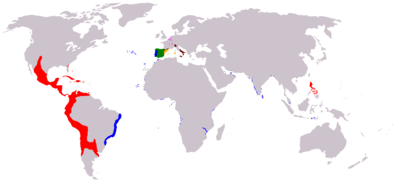Council of the Indies

The Council of the Indies; officially, the Royal and Supreme Council of the Indies (Spanish: Real y Supremo Consejo de Indias, pronounced: [reˈal i suˈpɾemo konˈsexo ðe ˈindjas]), was the most important administrative organ of the Spanish Empire for the Americas and Asia. It was placed at start as a section under the jurisdiction of the Council of Castile and it had legislative, executive and judicial functions. The Crown of Castile incorporated the American and Asian territories into its domains by a papal bull issued by Pope Alexander VI. The Council of the Indies was abolished in 1812 by the Cádiz Cortes, restored in 1814 by Fernando VII of Spain, and definitively abolished in 1834 by Isabella II of Spain.[1]
History
Queen Isabella withdrew the authority granted to Christopher Columbus and the first conquistadors, and established direct royal control. The evolving structure of colonial government was not fully formed until the third quarter of the 16th century; however, the Catholic Monarchs (Isabella and Ferdinand) designated Juan Rodríguez de Fonseca to study the problems related to the colonization process arising from tyrannical behavior of Governor Christopher Columbus and his misgovernment of Natives and settlers. Rodríguez de Fonseca effectively became minister for the Indies and laid the foundations for the creation of a colonial bureaucracy. He presided over a council, which contained a number of members of the Council of Castile (Consejo de Castilla), and formed a Junta de Indias of about eight counsellors. Emperor Charles V was already using the term "Council of the Indies" in 1519. The Council of the Indies was formally created on August 1, 1524.[2] The king was informed weekly, and sometimes daily, of decisions reached by the Council, which came to exercise supreme authority over the Indies at the local level and over the Casa de Contratación founded in 1503 at Seville as a customs storehouse for the Indies. Civil suits of sufficient importance could be appealed from an audiencia in the New World to the Council, functioning as a court of last resort.[3]
Internecine fighting and political instability in Peru and the untiring efforts of Bartolomé de las Casas on behalf of the natives' rights resulted in Charles's overhaul of the structure of the Council in 1542 with issuing of the "New Laws."
The terms of trade between the far-flung colonies and Seville, the port through which all trade flowed, was controlled by the existing Casa de la Contratación at Seville which was authorized (1503) to control colonial commerce, emigration, and maritime enterprise.[4]
The large volume of Council and Crown's decisions and legislation for the Indies were formally codified in the 1680 publication, the Laws of the Indies (Recompilación de las Leyes de Indias) and re-codified in 1791.[5]
With the ascension of a new dynasty at the start of the eighteenth century, a series of administrative changes, known as the Bourbon reforms, were introduced. In 1714 Philip V created a Secretariat of the Navy and the Indies (Secretaría de Marina e Indias) with a single Minister of the Indies, which superseded the administrative functions of the Council, although the Council continued to function in a secondary role until the nineteenth century. Fifty years later Charles III set up a separate Secretary of State for the Indies (Secretarío del Estado del Despacho Universal de Indias).[6] During the Peninsular War, the Cádiz Cortes abolished the Council, but it was restored upon Ferdinand VII's restoration. The Council was finally abolished in 1834, a year after Ferdinand VII's death and after the loss of most of Spain's empire in the Americas.
The archives of the Council, the Archivo General de Indias one of the major centers of documentation for European history, are housed in Seville.
See also
References
- ↑ El Consejo Real de Castilla y la Ley
- ↑ Gibson, Charles (1966). Spain in America. New York: Harper & Row. p. 92.
- ↑ Gibson, 94-95.
- ↑ Gibson, 100-102.
- ↑ Gibson, 109-110, note 24.
- ↑ Gibson, 167-168.
Further reading
- Burkholder, Mark A. Biographical Dictionary of Councilors of the Indies, 1717-1808. Westport: Greenwood Press, 1986. ISBN 0-313-24024-8

.svg.png)